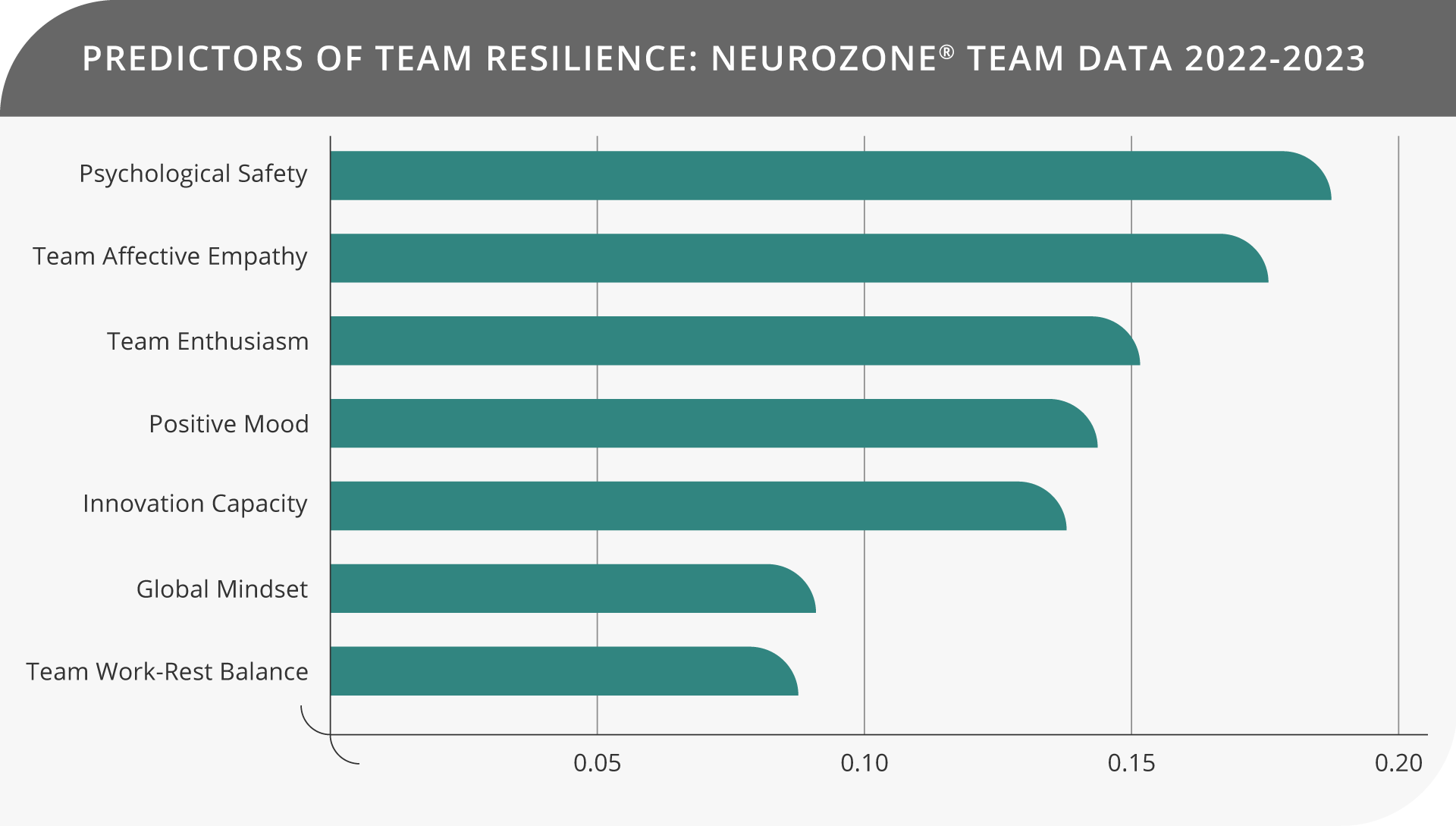Author: Tyler Phillips, Research Psychologist and Lead Content Specialist
In an effort to measure the collective resilience of a team, we have created the Team Neurozone® Resilience Index. This index is a pioneer of its kind, for a few reasons. Firstly, it is based on the individual-level Neurozone® Resilience Index, a validated and published measure of human psychological resilience. Secondly, most measures of ‘team’ resilience simply tend to average the individual resilience levels of a team’s members, assuming that the whole is the sum of its parts. In contrast, knowing the flaw in this assumption, our Team Neurozone® Resilience Index (Team NRI) asks individual team members to speak for the team, not for themselves. The Individual and Team NRIs allow us, therefore, to inspect the sum of the parts and the whole, separately.
As more and more teams use the Team NRI, we gather more and more data to help us statistically validate this reliable and theoretically grounded measure of team resilience. Not only that, this data also helps us establish which team-level behaviors and dynamics can result in changes on the Team NRI, and to what degree. Let’s call these behaviors and dynamics ‘Paths’ to team resilience and high performance. There are 29 Paths in the Neurozone® Team Assessment, all of which are valid, reliable, and significantly correlated with the Team NRI. This means that optimizing each Path is associated with an increase in the Team NRI score.
But we aren’t satisfied with just that. We are also interested in seeing which Paths have stable, predictive power for changes on the Team NRI. In other words, we want to know which Paths, if optimized, will likely cause (predict) an increase in the Team NRI, and will do so reliably (hence, are stable).
As we get new data, more Paths will likely be added to the list of predictors, and their relative rankings (i.e. the degree to which they predict change compared to other Paths) may also shift. At the moment, however, our team data comprises:
- 291 team members from around 50 teams,
- A more or less equal gender distribution of team members,
- Teams from around 14 countries, 16 industries, and 21 divisions/departments, and
- Teams that operate across all job levels.

Based on this data, we have so far identified 7 Paths which, when optimized, reliably predict an increase in the Team NRI. They are:
- Psychological Safety: whether team members feel free to voice their opinions (and whether these opinions matter), whether they are able to freely and actively participate in important conversations, and whether they are sympathetic towards one another.
- Affective Empathy: whether team members find it easy to identify with each other's emotions, 'feel' each other's feelings, and relate to what each other is going through.
- Team Enthusiasm: whether the team is enthusiastic and inspired and whether members motivate one another.
- Positive Mood State: whether the team has an overall sense of well-being and generally feels happy and content.
- Innovation Capability: whether innovation is a top priority in the team, whether leaders encourage the team to be curious and to gather as much relevant information/knowledge as possible when problem-solving, and whether the team uses innovative problem-solving techniques like breaking the problem down into smaller parts or using the 'what if?' question to solve it.
- Global Mindset: whether the team values the importance of global interconnectedness in business, mindfully cultivates an increasingly diverse global network, and stays on top of new international developments in the market.
- Team Work-Rest Balance: whether the team values the importance of a work-rest rhythm, whether members believe that taking leave is a necessity, not a privilege, and whether they encourage one another to take sufficient time away from work to rest and rejuvenate.
These predictors exemplify the importance of holistically optimizing the team as a living system. Each of Neurozone’s Five Domains of High Performance (Rhythms, Energy, Connectors, Transformers, and Innovators) is represented by at least one of these predictors. Team Work-Rest Balance reflects the organic Rhythmic needs of individual brain-body systems, in that they must enter periods of rest and maintenance after active periods of work. This need also honors the finite Energy of the brain-body system – Energy which is then boosted by the Paths of Team Enthusiasm and Positive Mood State. Thirdly, the crucial elements of Connection – supported by Affective Empathy and Psychological Safety – enable team members to curb loneliness and to ‘plug in’ to the larger system, where synergy and synchrony can unfold. In tandem, a team’s Global Mindset helps it secure the Transformative sense of having a larger purpose in the world. Finally, against this meaningful backdrop, a team can then pool together its knowledge, skills, expertise, and experience to learn, grow, and solve problems and fashion solutions in novel ways through an enhanced Innovation Capacity.
As more teams use the Neurozone® Team Assessment system, the data will undoubtedly reveal how the other Paths impact team resilience and high performance. These capacities, after all, are dynamic, with different conditions and stakes in different moments and contexts influencing which behaviors and dynamics will deliver the highest yield for the lowest energy to keep teams not just afloat, but in a state of peak, adaptive performance.